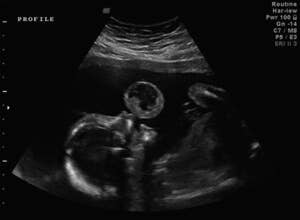Surgeons Perform In Utero Surgery To Successfully Remove Tumor From Fetus

Share
It was an expectant parents’ worst nightmare: an ultrasound image revealed that their unborn baby had a large tumor growing from its mouth. Even worse, if the tumor were allowed to grow for the duration of the pregnancy, there was a good chance the baby would die from excessive bleeding. The only way to save the baby’s life would be to perform a difficult and risky operation to remove the tumor while the baby was still in the womb. The operation, perhaps the first of its kind, was performed in 2010. The now 20-month-old Leyna Mykaella Gonzalez is doing fine, and the surgeons who saved her life are ready to tell her amazing story.
Back in early 2010 Tammy Gonzalez, then 20 weeks pregnant, saw what resembled her baby blowing a bubble about the size of a peach on an ultrasound image. Doctors determined the “bubble” to be a fetal oral teratoma, a rare tumor that occurs in between one in 35,000 to 200,000 live births. Tammy and her husband were told that the baby stood little chance of surviving birth, and even if she did, she would have to undergo an immediate tracheotomy to allow her to breathe, and numerous subsequent surgeries. Furthermore, the baby would probably be disfigured.
That was when the two sought out Dr. Rubén Quintero, the director of the Fetal Therapy Center at the University of Miami. Dr. Quintero had pioneered a procedure known as operative fetoscopy that involves operating on the fetus with a laser. It’s relatively non-invasive, requiring just a small incision to the mother’s abdomen. Ultrasound and an endoscope are used to guide the surgery. Dr. Quintero and his wife, fetal surgeon Eftichia Kontopoulos, performed the surgery on Gonzales in May 2010. The surgeons had guided the laser to a “stalk” that held the tumor to Leyna’s upper lip, sliced the mass off and let it fall away into the amniotic fluid. The surgery lasted just 68 minutes and required only local anesthesia.
Gonzales, awake throughout the surgery, watched the surgeons’ progress on a monitor. She told the Guardian, “When they finally severed the whole tumor off and I saw it float away, it was like this huge weight had been lifted off me and I could finally see her face – and it was perfect.”
On October 1, 2010, Leyna – which means “little angel” – was born, weighing just over 8 pounds. She had a small scar on the corner of her mouth. Otherwise, she was completely healthy. To the surgeons’ knowledge it was the first time a fetal oral teratoma had been successfully treated in utero. They published the case report this month in the American Journal of Obstetrics & Gynecology.
Be Part of the Future
Sign up to receive top stories about groundbreaking technologies and visionary thinkers from SingularityHub.


In utero fetoscopic surgeries remain rare and Drs. Quintero and Kontopoulos acknowledge that more need to be performed before its safety and efficacy can be adequately evaluated. Operating on the fetus while still in the womb has the potential to decrease mortality associated with complications at birth, and treating physical malformations early can improve future quality of life.
Dr. Quintero has also used the laser surgery to treat twin-to-twin transfusion syndrome (TTTS), a condition resulting from the unequal blood flow between two fetuses sharing a common placenta. Also a rare procedure, Dr. Quintero remains one of a small few physicians who correct TTTS with laser surgery.
Successfully performing delicate procedures on a fetus while still in the uterus can seem miraculous. But as surgeons like Quintero and Kontopoulous continue to make firsts, the procedures will increasingly become a feasible option for couples. And just as the Da Vinci robot that is already widely used to perform prostate and other surgeries, it seems fetoscopic surgeries could also benefit from robotic manipulation.
Just like Leyna, whose life it saved, fetoscopic surgery has a bright future to look forward to.
[image credits: American Journal of Obstetrics & Gynecology]
images: American Journal of Obstetrics & Gynecology
Peter Murray was born in Boston in 1973. He earned a PhD in neuroscience at the University of Maryland, Baltimore studying gene expression in the neocortex. Following his dissertation work he spent three years as a post-doctoral fellow at the same university studying brain mechanisms of pain and motor control. He completed a collection of short stories in 2010 and has been writing for Singularity Hub since March 2011.
Related Articles

These Robots Are the Size of Single Cells and Cost Just a Penny Apiece

In Wild Experiment, Surgeon Uses Robot to Remove Blood Clot in Brain 4,000 Miles Away

A Squishy New Robotic ‘Eye’ Automatically Focuses Like Our Own
What we’re reading

